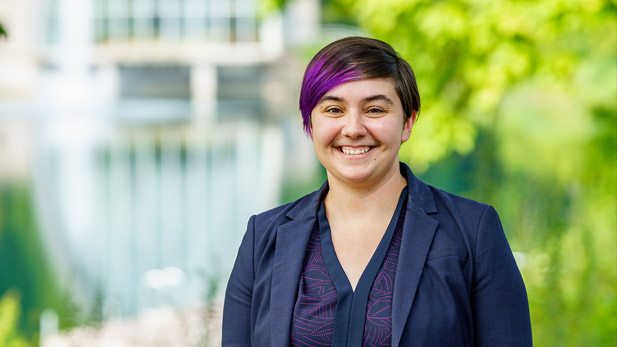Nicole Pfiester Instills a Love of Physics to the Masses Through Social Media

Assistant Professor of Physics and Optical Engineering, Nicole Pfiester, wants to share her love for physics and nanofabrication with the masses, and sees social media as a way to do that.
Nicole Pfiester is not your old school professor. Pfiester, a first-year assistant professor of physics and optical engineering, wants to share her love for physics and nanofabrication with the masses, and she sees social media as a way to do that.
“[Communicating science through] social media is a great way to increase visibility,” says Pfiester. “It’s a lot easier to find someone on social media who looks like you, no matter what they look like. Students may see something online and think, ‘They’re a scientist and have a Ph.D. and I can do that too’.”
Pfiester grew up in Greenwood, Indiana, and earned her bachelor’s degree in physics from Purdue University. She went on to Tufts University where she obtained a master’s degree in electrical engineering and joint Ph.D. in electrical engineering and material sciences. After doing two years of post-doctorate work at Ohio State University, she joined the faculty at Rose-Hulman.
“Physics is one for those things that really does explain everything at its core,” says Pfiester. “But physics and math suffer from a poor reputation as being boring and dry. Yet if you talk to the professors who teach those subjects, we’re exciting and engaging. We’re doing interesting things. [Using social media] is a way to show that and help students feel that excitement.”
While Pfiester is just venturing into the realm of social media to reach prospective and current students, this type of information dissemination is not new to the world of science outreach. She credits Carlotta Berry, Ph.D., Rose-Hulman professor of electrical and computer engineering, as someone who has inspired her and is creatively using social mediums such as Twitter to interact and engage with students. In the vein of “edutainment,” scientists also use YouTube and TikTok to create videos and rap parodies to create short and teachable science concepts that make physics and engineering more approachable.
Many scientists and science organizations — NASA, for example — share visuals on social media to reach a broader audience. Pfiester started her foray into social media using that approach. She shares photos of her work on Instagram and recently started creating short videos on Tik Tok, under the handle “nanofabulous” and the tagline, “physics professor with a love for all things nano.”
“Nano” is short for nanofabrication, which is one of Pfiester’s primary research focuses. As Pfiester describes it, nanofabrication is essentially making very, very small things.
“We’re used to making stuff with our hands and use scissors and cut things that fit into our hands,” she says. “When we start getting smaller and smaller, and below the point where you can see with your eyes anymore. You use an electron microscope to see and use special techniques to build them. That’s what I do with the clean room here are Rose, make microstructures and nanostructures.”
To help explain the concept, Pfiester uses the example of a human hair. One strand of hair is 70 microns wide. If a nanostructure is 100 nanometers big, several hundred of those can fit on the width of one human hair
“My expertise is making very small things that can manipulate light and how it interacts with that surface,” says Pfiester. “Where I like to live is where we make devices to go along with light cameras or improve the efficiency of photovoltaics. For example, you look at a magnifying glass. The focal point is not great because the lenses are huge and thick. But with a meta material, using nanofabrication, you can make a flat lens so it’s much skinnier and smaller. You reduce the size and weight of the optics you need on traditional imaging systems. You can do things like put those lenses on a satellite to look at stars or put it inside the body.”
How does Pfiester share this type of nanofabrication work on social media?
“You can’t see the individual structures because they’re so small, but you can see the light bouncing off it in rainbow structures,” she says. Those images are ripe for sharing and a great way to help students engage with physics.
Whether it’s through social media or teaching in labs and classrooms, Pfiester loves teaching and lives for the “aha” moments when her students grasp a difficult concept. She strives to be a different type of professor; one that she did not have as a student.
“For me, college was hard, and I felt like I couldn’t approach my professors,” she says. “I find great joy in teaching because I try to do the opposite. Being closer to that undergraduate experience and remembering what that was like is beneficial as a teacher.”